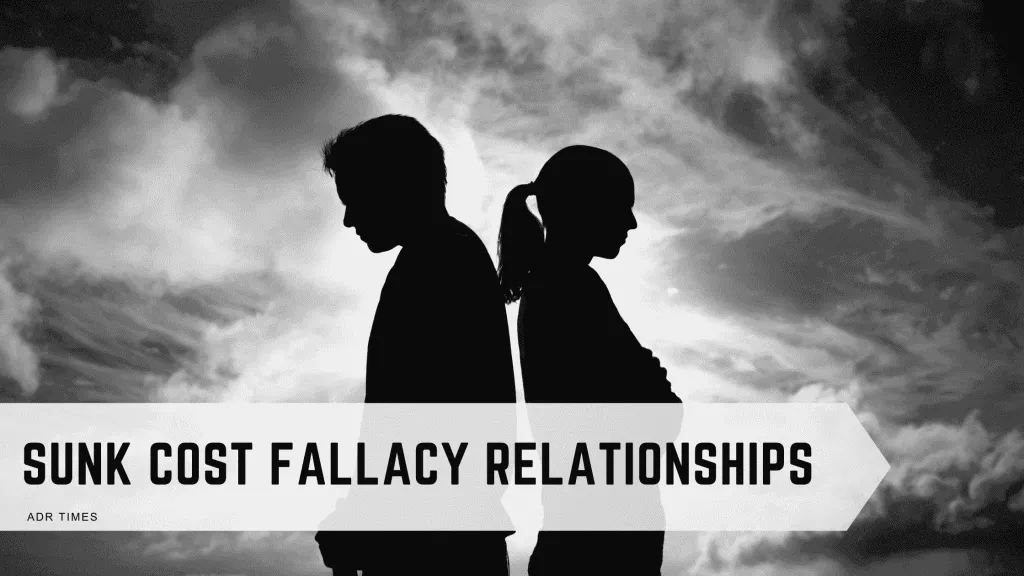
We’ve all been there, and by “there,” we mean in a sunk cost fallacy relationship. Many people will feel an overwhelming loss at the end of a relationship, responding not only to the loss of the experience but also to the loss of all of the time, energy, and memories that were a part of that experience with that other person.
If this is the case, the couple may end up staying together because of the time and the memories that they have together, even if it is not the healthiest option for them. Couples in unhappy or bad relationships often stay together because they feel that their past investment will eventually pay off.
The sunk cost fallacy describes the decision-making process based on “sunk costs,” these past costs are so much time, resources, and effort wasted, specifically in romantic and business relationships.
Learning when a relationship may be in this sunk cost phase and how to remove yourself from that situation healthily can be difficult, but it will often be the healthiest option. Learning from failure and a bad past investment and focusing on the future is often easier said than done. This article will examine the fallacy and its impact on relationships, as well as provide some tips to help remove yourself from that situation.
Sunk Cost Fallacy Explained:
The sunk cost fallacy is an economic concept revolving around humans’ tendency to continue investing in something that they have already invested a significant amount of time or money. Essentially, they throw good money after bad in the hopes that they can justify their decision and continue investing.
The longer that someone has been working on the investment and the more time and energy they have put into it, the more likely it will be that they will continue the investment, no matter how poorly the investment is performing. This is an example of sunk cost bias toward an endeavor resulting from time passing.
The sunk cost bias is related to loss aversion, which states that humans prefer to avoid what is perceived as the greatest loss. The sunk cost fallacy results when the largest loss perceived is the loss of the investment already made in the endeavor. Often, the sunk cost effect does not take into account any future costs that will be required to continue with the investment, pushing people to make poor financial decisions.
The sunk cost effect can be found in investments, negotiations, and even relationships, and it can end up impacting major future decisions and costing the person relying on the fallacy a significant amount of time and money if they keep throwing good money after bad.
Learning when and how to keep yourself from falling prey and untangling yourself from a situation resulting from sunk costs or the sunk cost fallacy is an important skill that needs to be identified and encouraged.
Sunk Cost Fallacy Examples in Real Life:
- Gambling or risking more money in an attempt to make up for lost bets
- Sticking with a movie/book/major/job/career even though you hate it
- Staying in an unhappy marriage because you’ve been together for so long, but it is no longer serving its purpose
- Staying in a bad relationship with a friend or significant other where it’s unlikely to improve
Impacts on Relationships:
As mentioned above, the sunk cost fallacy can find its way into a relationship, particularly a long-term one that has run its course. When the couple needs or wants to break up, the thought of leaving behind the time, effort, money, and energy spent building a life together can cause them to guess their decision second. Oftentimes, it can cause couples to double down and invest more time and effort in trying to make it work, even when it is unhealthy or incompatible.
The fear of being wrong and ending up alone forces most people to stay in their situations, regardless of any pain and costs already paid. Some common examples of sunk costs examples include:
Time:
One of the biggest reasons many couples will try to make their marriages or relationships work is the time they have spent together. Many couples realize they have spent significant time with this person and cannot return to spend time with someone else or themselves. This is the most common reason people stay together.
Kids:
Another reason many couples may fall into the sunk cost fallacy is that they have children together. Children are a decision that the couple chooses to make together, and the idea of having to raise them separately can often feel overwhelming. Investing in the children’s lives can be difficult separately as well, so it can often encourage couples to stay together for the sake of their children, even if it is an unhealthy situation.
Friends:
It can be common for those couples who have been together for a long time to have the same group of friends. This can make breaking up hard because it can also involve losing friends you have worked so hard to connect with. This doubles the sunk cost fallacy that takes effect in this case.
Assets:
Especially if the couple is married, there will often be many assets that they will have to sell and divide. Many couples will not get a return on their investments in some of the assets, and it can be challenging to imagine attempting to separate these assets and the investments contained in them. Because of this, many couples will choose to stay together instead.
Memories:
Ending a relationship can be difficult because of the number of memories that the couple shares together. It can be difficult to think of all your experiences with a person becoming something that you did with someone who is no longer in your life. Thinking about separating the memories and not experiencing them for ourselves can feel like a lost cause.
Considering how the sunk cost fallacy can impact a relationship and push couples to waste more time and resources in an attempt to stick it through rather than amicable separating demonstrates the difficulty and insidious nature of this fallacy.
Leaving the Relationship & Taking a Loss
Learning how to overcome a failed relationship is not easy. However, the couple can take some considerations and steps to break up healthily and move forward.
They include:
- Acknowledgment: The first step in most problems is acknowledgment. Couples and individuals must admit wanting to end the relationship and move forward, but the sunk cost fallacy stops them from doing so. Acknowledging this will help them move forward.
- Confidants: Telling a few trusted people can make moving on easier. They can help encourage steps toward leaving while also being a space to process the feelings. They can help you focus on the future and why leaving is better and potentially help you ignore or talk through the feelings of the past.
- Ritual: Often, the repetitive reliving of the good memories at the end of a relationship will push the couple into a sunk-cost fallacy tailspin. To avoid this, creating a ritual where you enjoy the memory once but then put it to rest through a closure ritual can be helpful. Doing so will put a hard stop to the repetitiveness of the memory and encourage couples and individuals to remember the good while also acknowledging that leaving will be the healthiest.
- Plan: Having exciting plans for the future can help make the past less appealing. Booking a vacation, signing up for a new class, or finding a new place to live can give you something to look forward to and help you move past the past.
Final Thoughts
Leaving a bad relationship or a bad investment is never easy. Our resources and time are minimal, so understandably, we never want them to go to waste. But it is best to look to the future when things run their course and outrun their benefits. Admit the failure, learn from the experience, and, more importantly, appreciate the experience. It may not have turned out as you had hoped, but it was a necessary experience, usually with an unforgettable lesson.
Check out ADR’s blog to learn more about sunk cost fallacy relationships, communication, and more!
Must-read Articles:
- Divorce Mediation Attorney: How They Can Help - July 19, 2024
- Divorce Mediation: What You Need to Know - July 17, 2024
- Negative Reinforcement for Positive Behavior - July 15, 2024


